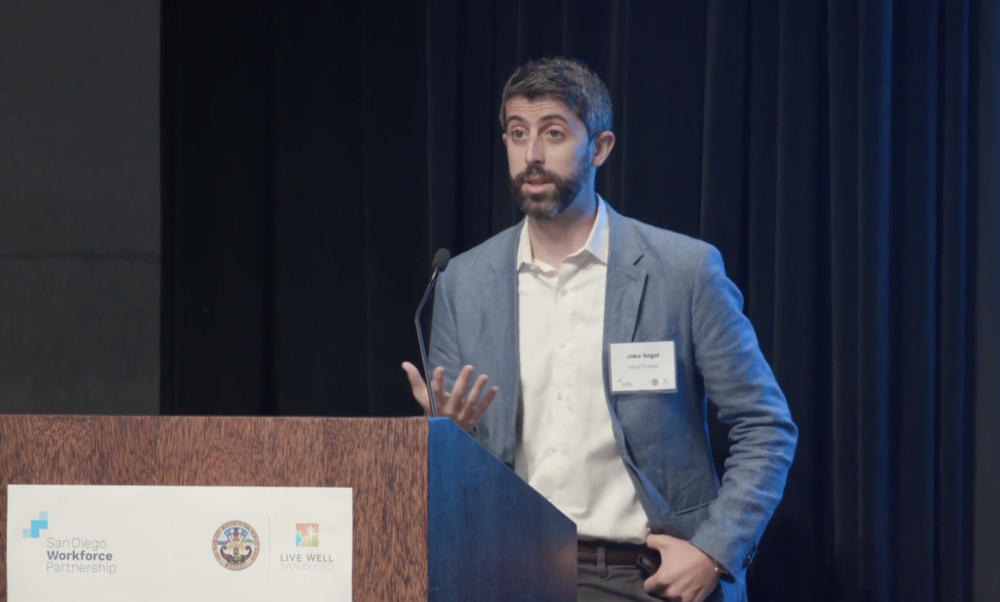

Public Sector Solutions, Results-Based Funding
Amber Ivey joined Social Finance in December 2022 to help governments maximize the measurable impact of taxpayer dollars with the goal of delivering better outcomes for people and communities. Here, Amber talks about her journey from commercial logistics to government improvement, her passion for data, and her run for Congress.
What drew you to Social Finance?
Amber: I learned about social impact bonds in graduate school at the University of Maryland when I was getting my master’s in public administration and I thought it was such an innovative idea. When Social Finance reached out to me about a potential position, I saw that the organization was really focused on outcomes and using data to help improve government programs. That’s what led me here. My whole purpose, I believe, is to help governments work better for the people they serve. I’m agnostic to the approach, as long as we’re leading with people, data, and performance improvement. The work here excites me and the values here align with mine.
You’ve been working to generate measurable impact within or adjacent to the public sector for some time. How did you originally get started in this work?
Amber: As a young person, I wanted to be a lawyer but when it came down to it, I didn’t want to spend so many years in school. Although I did end up getting my law degree and love working in the intersection of data, public policy, law, and technology, I started my career as a logistics manager. I’m really an operations and performance management person at my core—I love data and helping people and things work better. The problem with this was that I was working for a for-profit company and I asked myself, “What am I doing with my life?” I needed to see impact and not just in a company’s bottom line.
I wanted to improve lives and started to try and figure out what that work would look like. That’s when I learned about public administration. Even though both of my parents served in the military and worked for the government, I didn’t think about that career path. I found a health and human services agency near my logistics job that needed volunteers and I began working with women transitioning out of prison, people who had lost children in the child welfare system and needed work. I worked to help these women find gainful employment and deal with everything else. These individuals faced so many barriers and, at the time, I didn’t understand why. So, I realized that I wanted to help governments do this kind of work more effectively.
I went back to school to get an MPA and I had a professor who worked in the Government Accountability Office point me toward Stat programs, which are data collection and analysis initiatives designed to help state and local governments make better decisions. I lived in Maryland at the time so I was close to two well-known Stat programs: Baltimore CitiStat and Maryland StateStat, both of which former Maryland Gov. Martin O’Malley started. I really loved what they were doing in those programs. They weren’t focused on singular agencies but helping across their respective cabinets. I was employed at StateStat during my last semester at the University of Maryland—I had the opportunity to onboard new agencies and help Gov. O’Malley pursue his policy goals. I thought, “Yeah, this is where I need to be.” I loved it so much that I continued working with Gov. Larry Hogan’s administration and helped create the Governor’s Office of Performance Improvement.
I want our public sector partners to remember that government has always been an innovator in this country—we went to the moon because of government, developed the internet because of government. We have amazing folks embedded in our local, state, and federal agencies and departments who can do awesome things.
Your experience with and passion for data runs deep. Throughout your career, you’ve advocated for the efficient use of data within the public sector as complement to “gut instinct.” What are some of the key roadblocks to widespread government data use and sharing, and what we might do to address them?
Amber: Some folks are against using gut instinct, saying, “Hey, everything should be data driven.” I’m not that person. I think we need to pair gut instinct and data because when you use both, you get a good intersection for decision making. The reality is, most leaders across sectors rely on their guts to drive decisions. What I’ve done throughout my career is help these leaders and their staff improve their decision making by offering data and facts.
Over the last 20 or so years, government officials have become more data-driven but using data hasn’t caught on in the public sector as much as I would like—data isn’t used in all decisions. There’s a few reasons why:
One, governments often don’t have enough staffing. They don’t have enough people with the right skills or partnerships with universities or other entities that could do the data work for them.
Two, there’s very limited data sharing among government agencies. Now I’ve heard many times that government staff want to maintain ownership over the data, and I understand that, but sometimes it goes too far and prevents public sector professionals in the same office, the same department, or the same agency, from sharing data. There has to be a middle ground so that valuable information can be shared and used to better serve people and communities.
During my time at The Pew Charitable Trusts, I actually did research on how states use data to inform decisions and Virginia is an example of a state that has done this well. Between 2010 and 2015, the state got everyone around the table and improved data collection, sharing, and analysis related to homelessness, particularly among veterans. They brought in participants and stakeholders who had ownership over different portions of the data and in the end, were able to enable sharing in a way that led to a lot of folks getting housed. Yes, privacy is important and we need to keep people safe but we also need to share data to actually improve lives.
The last barrier to widespread data adoption among governments I’ll touch on is data quality. We need to ensure that the folks collecting data understand the importance of that task, as data quality correlates directly to impact. It is more than typing in numbers, the data can literally change lives and help practitioners to do their jobs more effectively.
In 2020, you ran for a seat in the U.S. House of Representatives for Maryland’s 7th Congressional District. Could you talk about that experience?
Amber: Throughout my career, I’ve worked with data and technology. I knew back in 2019 that technology was developing quickly—we’ve seen that recently with the emergence of artificial intelligence—but I felt that Congress wasn’t ready for this and what it would mean for the future of work. That was one of the main reasons I ran for a House seat. I felt then, as I do now, that governments need to understand how to use data and technology safely and in a way that benefits people and communities.
I want our public sector partners to remember that government has always been an innovator in this country—we went to the moon because of government, developed the internet because of government. We have amazing folks embedded in our local, state, and federal agencies and departments who can do awesome things. Government should innovate because it’s always been innovating and should remind all sectors that it can still innovate.
The advisory team is currently navigating a dozen projects across more than eight states—which of these engagements are you most excited about?
Amber: I’m working on some projects in Texas focused on helping folks get housing, learn vocational skills, and then find good jobs. I also have a project in Wisconsin focused on assessing their TANF program. I am excited about this work and looking forward to continuing to help government work better for the people it serves.
Learn more about our Public Sector Solutions →
Related Insight

Meet Social Finance’s Vice President, Head of Impact Advisory and Public Sector Practice Jake Segal
Jake Segal recently assumed leadership of Social Finance’s Public Sector Practice, which he helped establish after joining the organization in 2014. Jake discusses his new role and the continued evolution of the Public Sector Practice.

Meet Social Finance’s New Vice President, Government Relations, Sandra Salstrom
Sandra Salstrom joined Social Finance in October 2021 to lead government engagement efforts. We spoke with Sandra about her new role and the importance of building connections with government partners.